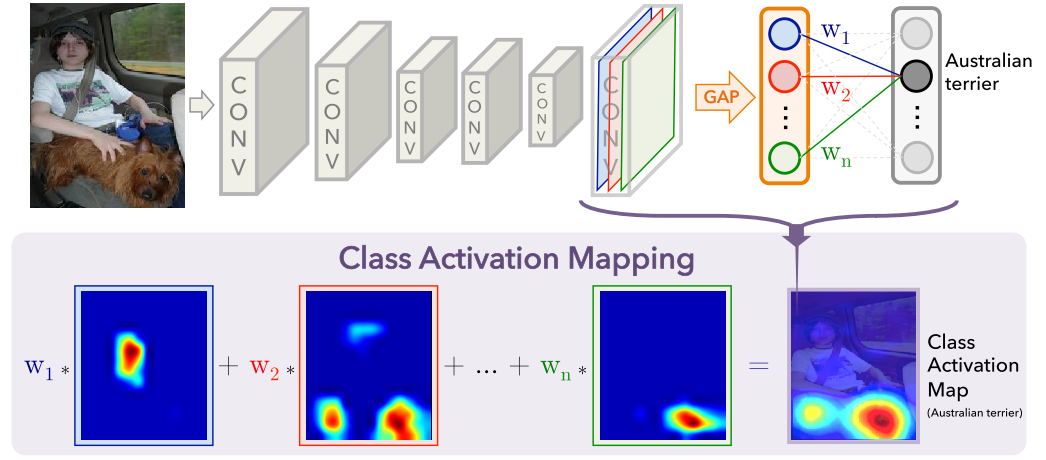Code
# imports
import ast
import json
from copy import deepcopy
import imageio
import matplotlib.pyplot as plt
import torch
import torch.nn.functional as F
from torch import nn
from torchvision import models, transformsPramesh Gautam
August 5, 2022
Class activation map was introduced in Learning Deep Features for Discriminative Localization. It was introduced to use the classifier networks for localization tasks. However it can also be used to interpret the models and figure out where the network focuses to classify a input. It uses the weights in the final layer to weight the feature maps in the final convolution layer. That weighted sum is used to see the activation map.

As seen in the figure above, once the input image passes through the CONV layers, let’s say it produces feature map of shape \(1\times2048\times7\times7\) for the image of input size \(1\times3\times224\times224\) in the format \(B \times C \times H \times W\) format. Global Average Pooling (GAP) will then sum the spatial dimension and produce output of shape \(1\times2048\) after collapsing across spatial dimension. There will be \(2048\times1000\) weights mapping from output of GAP layer to final layer (1000 number of classes in ImageNet). Once we classify the image, the corresponding 2048 weights mapping from GAP layer to FC layer are used to weight the 2048 spatial features of the last convolutional layer. These weighted features are then resized to the input image size to get the final feature map.
In the figure, the model predicts the input image as Australian terrier. Weights \(W_1...W_n\) are the weights that connect the output of GAP layer to the FC layer corresponding to the predicted class. We can say that the weights \(W_1...W_n\) are responsible to find the importance of each unit in GAP layer that leads to Australian terrier class in output. We use these weights to find the weighted combination of 2048 spatial features in final convolutional layer.
We’ll be using PyTorch hooks to extract the intermediate feature maps. Hooks are the functions that can be executed during forward or backward pass of the network. You can learn model about hooks here.
Here we are using hooks to save the feature maps of layer4, i.e. the final convolutional layer. We multiply the output of layer4 by the weights that map from avgpool layer to fc layer. Since weights can be extracted from the model itself, we only use hooks to save the output of laster convolutional layer.
Once we define attach hook to the model, the output of the layer to which the hooks was attached will be saved in the activation dictionary.
# define function to get predictions and required activations
def get_data(input_image, model, transforms):
# transform input image
input_data = transform(imageio.imread(input_image)).unsqueeze(0)
# imagenet labels to map from index to text label
labels = ast.literal_eval(open("imagenet1000_clsidx_to_labels.txt").read())
# attach hook to layer 4
model.layer4.register_forward_hook(get_activation("layer4"))
model.eval();
with torch.no_grad():
preds = model(input_data)
preds_softmax = torch.nn.functional.softmax(preds, dim=1)
top_prob, top_pred = preds_softmax.max(dim=1)
return top_pred, top_prob, labels[top_pred.item()], activation# image to test CAM
image = "images/n02102040_7490.jpeg"
# model to run inference
model = models.resnet50(pretrained=True)
# transforms to use ImageNet values for normalization
transform = transforms.Compose([
transforms.ToTensor(),
transforms.Normalize([0.485, 0.456, 0.406], [0.229, 0.224, 0.225])
])
# results
pred_class, pred_prob, pred_label, activation = get_data(image, model, transforms)
pred_class, pred_prob, pred_label(tensor([217]), tensor([0.8239]), 'English springer, English springer spaniel')torch.Size([1, 2048, 1, 1])torch.Size([1, 2048, 10, 14])torch.Size([1, 1, 10, 14])
As can be seen in the plot above, the network is able to focus on the dogs while classification. We can weight the features first and then resize the image or we can resize the features first and use the weighted combination. The results are identical. Below I have first resized the final feature maps and then used their weighted combination for plotting.
torch.Size([1, 1, 320, 426])Thank you for going through the post and I hope is was helpful to understand Class Activation Maps. I will add Grad-CAM in future post. Please post comments if anything is not clear or if you have any suggestions.
Bye :)